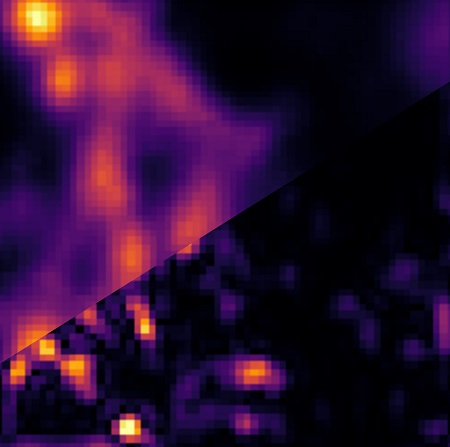WARSAW, Poland, Oct. 22, 2020 — A collaboration between researchers at the University of Warsaw and the Weizmann Institute of Science yielded a method of fluorescence microscopy that, in theory, has no resolution limit. In practice, the team demonstrated a fourfold improvement over the diffraction limit.
The technique, superresolution optical fluctuation image scanning microscopy (SOFISM), uses the naturally occurring fluctuations in emission intensity of fluorescent markers to further enhance the image scanning microscope (ISM)’s spatial resolution. ISM, itself an emerging technique, uses a confocal microscope in which a detector array replaces a single detector. In SOFISM, correlations of intensities detected by multiple detectors are computed.
In principle, the measurement of the nth order correlation can lead to a factor of 2n resolution improvement (with respect to the diffraction limit).
In practice, the resolution achievable for higher-order correlations is limited by the signal-to-noise ratio of the measurements.

A 3- × 3-µm confocal scan of microtubules in a fixed 3T3 cell labeled with quantum dots analyzed in two ways. Upper left: image scanning microscopy (ISM). Lower right: superresolution optical fluctuation image scanning microscopy (SOFISM) after Fourier reweighting. Courtesy of the University of Warsaw.
“SOFISM is a compromise between ease of use and resolution. We believe that our method will fill the niche between the complex, difficult-to-use techniques providing very high resolution and the easy-to-use lower-resolution methods,” said Radek Lapkiewicz of the University of Warsaw. “SOFISM does not have a theoretical resolution limit, and in our article, we demonstrate results which are four times better than the diffraction limit. We also show that the SOFISM method has a high potential in the imaging of three-dimensional biological structures.
“Until recently, SPAD array detectors were expensive and their specifications were not sufficient for correlation-based microscopy. This situation has recently changed. The new SPAD detectors introduced last year removed both the technological and price-related barriers. This makes us think that fluorescence microscopy techniques such as SOFISM might, in a few years’ time, become widely used in the field of microscopic examination.”
The research was published in Optica (www.doi.org/10.1364/OPTICA.399600).